Chinese hot and sour soup (酸辣湯 / suan la tang) is a traditional northern Chinese favorite packed with the acidity of Zhenjiang vinegar, the white pepper’s spiciness, and the sesame oil’s nuttiness.
The flavor becomes even more complex with the inclusion of bamboo shoots, dried mushrooms, and wood ear fungus and finishes with a beaten egg poured high above the soup to form multiple small egg ribbons floating on the thick soup.
You only need twenty minutes to prepare it. Make it at home to warm your family (and their hearts) with this utterly delicious soup with the iconic flavors of Northern Chinese cuisine.
This Szechuan hot and sour soup recipe is very close to the original hot and sour soup in Northern China, although I have left out ingredients such as ‘black tofu’ (see section 2 below), which is too exotic for most people.
It is way better than many substandard hot and sour soup that is merely a tasteless, gloopy mess of cornstarch paste.
Let’s take a look at how to prepare the Chinese hot and sour soup in detail:

Note: This post may contain affiliate links. Please read my privacy policy for more info. I may receive commissions for purchases made through links in this post. As an Amazon Associate, I earn from qualifying purchases.
Note: Some English recipes also translate hot and sour soup as Sweet and sour soup.
1. Step one- Preparing the meat
You need some lean meat to make this soup. The meat can be either pork or chicken breast. There are two ways to prepare the meat.
- You can put the whole piece of meat into the boiling water and let it boil until it is cooked. Remove the pork from the pot, and keep the water as the stock for making the soup. Place the meat on the chopping board and cut it into julienne.
- The second method is to cut the raw meat into the julienne and marinate it with light soy sauce, oil, and cornstarch. You only need to marinate the small pieces of pork for fifteen minutes. Marination enhances the flavor of the meat, and the cornstarch can make the velvety meat smooth. I am using this method in my Szechuan hot and sour soup recipe.
Note: You can omit the meat for a vegetarian version if you are vegetarian. Add more other ingredients slightly, and use vegetarian broth instead of chicken broth.
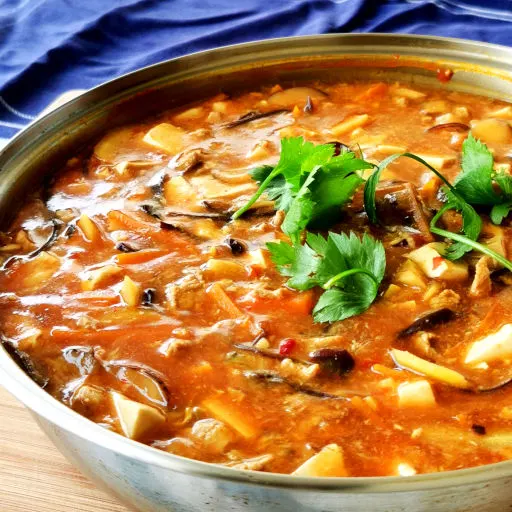
2. Step two- Preparing other ingredients
There are many variations of this soup. However, almost every recipe can find tofu, mushrooms, egg, and wood ear fungus. Here is a list of the common ingredients for this soup.
a. Mushroom
The Szechuan hot and sour soup recipe calls for Chinese dry shiitake mushrooms. Soak the mushrooms in water until fully hydrated, soft, and easy to cut. The time required varies from an hour to two or three hours, depending on the mushrooms’ thickness. If you have enough time, soak it in advance or even overnight. (Note: they will not be ‘over-soaked‘) Otherwise, soak the mushroom in hot water to speed up the process. You can use fresh shiitake mushrooms, but the flavor is not as good as the dried mushrooms.
Remove the stem, and cut the mushroom into thin slices. Set aside.
Tips: the water for soaking the mushrooms has loads of flavor. Use it as part of the liquid to make the soup. You can also use homemade chicken broth or store-bought chicken stock to enhance the taste.
You can use fresh mushrooms as a substitute. The best alternative is button mushrooms. Cut the mushrooms into thin slices as the dry shiitake, minus the soaking steps.
b. Bamboo shoot
Bamboo shoot is the essential ingredient of hot and sour soup. I am using the vacuum pack bamboo shoot imported from China, but I know that some places sell it in cans. You may also be able to get it online.
Cut the bamboo shoot into thin slices. I use about two tablespoons of bamboo shoot slices. You can increase the amount if you like the crunchiness of the bamboo shoot. I remember a Chinese chef mentioned on a TV program that cutting it lengthwise instead of crosswise can increase the crunchiness.
c. Wood ear fungus
Word ear fungus (wood ear mushrooms, black fungus) is used in many Chinese recipes. It should be available in the Asian market near you.
You must soak the dry fungus with water like the dry shiitake mushroom. The fungus will expand in size and turn soft once it is fully hydrated. Drain and remove the hard luster in the center. Cut the wood ear fungus into fine julienne. Set aside.
Wood ear fungus has a crunchy and slippery texture, which is quite distinct from any other food ingredients I have ever known.

d. Tofu
The ideal tofu for this soup should be soft, but it can be challenging to handle. I usually buy the firm tofu and cut it carefully into two. Then use a chef knife to it into slices and then julienne it. The trick to cutting tofu by not breaking it is to use the ‘minced’ action, chopping it with an up-down movement, not slicing it.
Transfer the tofu strips to a plate and set them aside. You should add the tofu to the soup after all the ingredients (except the egg) are cooked since it can break easily.
e. Carrot
You may also add some carrots to make the soup more colorful. Since other ingredients are julienne, the carrot is no exception.
f. Coagulated pig blood (a.k.a black tofu)
This item is not my favorite. The name does terrify some people, even the Chinese. So, they invented a much more acceptable term, black tofu (黑豆腐), to avoid mentioning it directly. The closest Western food is the black pudding, the staple English breakfast.
It looks like a piece of tofu, an authentic ingredient for Northern China’s traditional hot and sour soup. So, if you want the most authentic hot and sour soup, go for it. Otherwise, skip it, which is what most people do nowadays.
g. Ginger
Add a few slices of fresh ginger to the soup to make the flavor. Since we only want the taste of ginger, discard it after the cooking.
h. Egg
The egg is another must-have ingredient for the soup. I will elaborate on how to add it to the soup in step 4.
I. Dried lily buds (dried lily flowers)
This item is optional. You must rehydrate it before use, just like the wood ear fungus.
You may also want to try Chinese Chicken and Corn Soup on this blog.
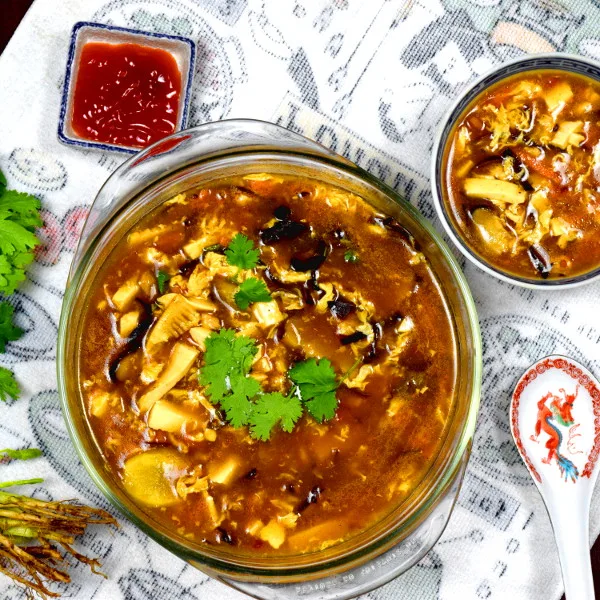
3. Step three- Preparing the seasonings.
Combining vinegar, white pepper, and sesame oil creates a flavor iconic to the authentic hot and sour soup recipe.
a. Zhenjiang vinegar (Chinkiang vinegar)
Zhenjiang vinegar 镇江醋 is the best in this soup, and the close alternative will be the red vinegar 浙醋。 Zhenjiang vinegar has a sharp sourness note. Red vinegar is mellower than Zhenjiang vinegar and is used primarily as one of the ingredients for marinade and sauces. You can use any rice vinegar or white vinegar if you do not have Zhenjiang vinegar.
Vinegar should only be added during the final cooking step since it is volatile and loses its flavor after prolonged cooking.
b. Sesame oil
Add a teaspoon of sesame oil before serving. We want the flavor of sesame. So, you should never substitute it with other oils.
c. Ground white pepper
The hotness of the soup originates from the pepper, not the chili. Ground white pepper is used for this soup by everyone, not black pepper.
The white pepper will release a bitter taste if heated for too long. Add it to the soup in the final step of cooking.
Note: Some readers reported too much pepper in the soup recipe. However, the amount is what we usually use locally, and it is entirely acceptable to reduce the amount should you prefer a milder taste.
d. Chili bean paste (Toban Djan) 豆瓣醬
This sauce provides the flavor of chili peppers and broad bean paste. It is a convenient way to add Szechuan flavor to any cuisine. However, some people will skip this by adding chili oil to the soup to provide the hotness of chili paper and create the signature red hue of the hot and sour soup.
e. Light soy sauce
Add some light soy sauce to marinate the meat and to the soup. Soy sauce is the magic seasoning ingredient for Chinese cooking, high on umami.
f. Dark soy sauce
A small amount of dark soy sauce helps to darken the color of the soup. You will see the familiar color of the hot and sour soup once you add the dark soy sauce and the chili bean paste to the broth.
4. Step four- Cook and serve
a. Cornstarch slurry
Add the cornstarch slurry before, not after, forming the egg drops.
The corn flour will thicken the soup and give the soup a smooth mouthfeel. Add the right amount of cornstarch slurry until you get the desired consistency.
b. Egg
Adding an egg can turn the hot and sour soup into an egg drop soup.
Pour the egg liquid into the soup by slowly dropping it at a high position in a thin stream in a circular motion. Wait a second or two, and use the ladle to push the egg strands around lightly. The egg strands will break into short pieces and form many small ribbons.
Do not over-stir the eggs. That is why I adjusted the consistency and flavor of the soup before adding the eggs.
5. Final adjustment of the flavor
Add the Zhenjiang vinegar, white pepper, and sesame oil to the soup. The three ingredients are added last, as prolonged cooking can reduce the intensity of their flavor.
You can now have the final adjustment of the flavor. Add more vinegar and pepper if you want a more intense flavor or some extra soy sauce for stronger umami. Add some chopped coriander on top to garnish.
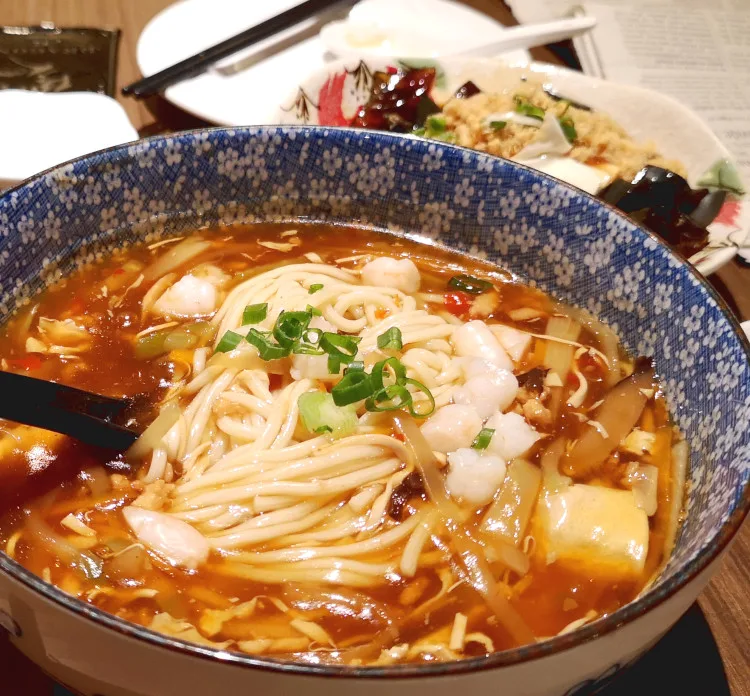
6. Turn your hot and sour soup into a savory soup noodle.
Make a twist of the easy hot and sour soup recipe with some added lamian (Chinese handmade noodles) for a complete meal. The noodles behave like a sponge, soaking up all the flavors from the soup base.
You can concentrate the soup more by reducing the water or increasing the seasoning (vinegar, salt bean paste, soy sauce, etc.), as the noodles will dilute the flavor.
Blanch the noodles in a pot of water until the noodles are soft and al dente. You can refer to the instructions on the packaging, as it varies from brand to brand. Drain the noodles and place them in a large ceramic bowl. Ladle the hot and sour soup and garnish it with some chopped scallions (green onions).
You can vary the ingredients of the soup, too. For example, use scallops or shrimp for the seafood version instead of meat. Also, omit the meat and add some firm tofu if you prefer it to be vegetarian.
7. Related Szechuan recipes
If you like this Szechuan hot and sour soup, you may also want to try some other Szechuan recipes on this blog:
- Szechuan spicy wonton (红油抄手) is spicy and savory thanks to the combination of a myriad of herbs and spices. The sophisticated flavor has earned it an indisputable place on the restaurant menu.
- Twice-cooked pork (回锅肉) is simmered in water, followed by pan-frying, and enrobed in a glossy, thick, gorgeous sauce. It has a rich, savory flavor and is slightly spicy, which is the hallmark of Szechuan food.
- Dan Dan Noodles (担担面) is a dry noodle dish with a strong savory flavor due to the combination of Sichuan peppercorn, chili oil, minced pork, vinegar, and siumiyacai (green mustard pickle).
Hot and sour soup
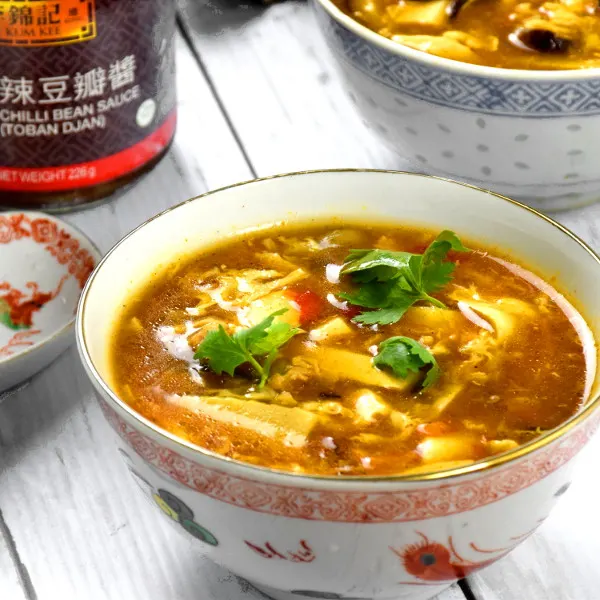
Hot and sour soup 酸辣湯 is a traditional northern Chinese favorite packed with the acidity of Zhenjiang vinegar, the spiciness of the white pepper and the nuttiness of sesame oil.
Ingredients
Ingredient (A)
Ingredients (B)
- 1 tablespoon bamboo shoot
- 2 Chinese dried mushrooms, , medium size (or 1 large size)
- 1 piece wood ear fungus, , about 10 g of dry weight
- 30 g carrots, cut into fine julienne
- 3 slices ginger
- 150 grams tofu, , medium firm
- 600 ml water, , or use chicken stock
Ingredients (C)
- 1 teaspoon dark soy sauce
- 1 1/2 tablespoon chili bean sauce
- 2 teaspoons salt
- 1/2 teaspoon sugar
Ingredients (D)
- 2 tablespoons corn starch
- 4 tablespoon water
- 1 egg, , beaten
Ingredients(E)
- 1 1/2 tablespoon Chinese vinegar
- 1/2 teaspoon ground white pepper
- 1 teaspoon sesame oil
- Chopped coriander to garnish
Instructions
- (Ingredient A) Cut the pork loin into fine julienne. Marinate with the light soy sauce, vegetable oil, and cornstarch for 15 minutes.
- (Ingredients B) Soak the dry mushrooms and wood ear fungus until they are soft and fully hydrated. Cut them into fine julienne. Cut three slices of ginger and set aside. Cut the carrots into julienne. Cut the tofu into strips.
- Bring the water to a boil. Cook the meat for half a minute. Then add the remaining ingredients in (B)into the pot and boil for two minutes.
- Add ingredients (C) to the above.
- (Ingredients D) Thicken the soup with the cornstarch slurry (corn starch mix with water), Then follow by adding the beaten egg.
- Remove from heat. Add ingredients in (E). Mix well and serve.
Recommended Products
As an Amazon Associate and member of other affiliate programs, I earn from qualifying purchases.
-
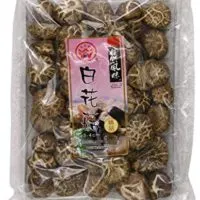 Havista Dried Premium Flower Shiitake Mushrooms, 6 Ounce
Havista Dried Premium Flower Shiitake Mushrooms, 6 Ounce -
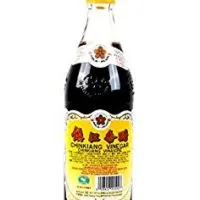 Gold Plum Chinkiang Vinegar 18.6 fl oz
Gold Plum Chinkiang Vinegar 18.6 fl oz -
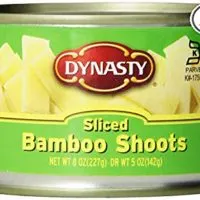 Dynasty Canned Sliced Bamboo Shoots, 8-Ounce (Pack of 12)
Dynasty Canned Sliced Bamboo Shoots, 8-Ounce (Pack of 12) -
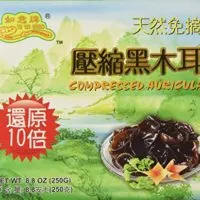 Premium Dried All Natural Compressed Chinese Auricularia Black Fungus Mushroom (Black Wood Ear Mushroom) - 8.8 Oz -- 10 Times Volume Yield After Soaking
Premium Dried All Natural Compressed Chinese Auricularia Black Fungus Mushroom (Black Wood Ear Mushroom) - 8.8 Oz -- 10 Times Volume Yield After Soaking
Nutrition Information:
Yield:
3Serving Size:
3 servingsAmount Per Serving: Calories: 300Total Fat: 12gSaturated Fat: 3gTrans Fat: 0gUnsaturated Fat: 8gCholesterol: 92mgSodium: 2055mgCarbohydrates: 29gFiber: 4gSugar: 6gProtein: 21g
This data was provided and calculated by Nutritionix on 5/23/2019

Ianinfrance
Sunday 30th of April 2023
2.5 tablespoons of cornflour mixed with 1 tablespoon of water. Is that not an error? It goes like cement!!! We're hoping to try this soup out but.....
We added nearer 4 tablesoons water and that worked fine.
KP Kwan
Monday 1st of May 2023
My mistake! You are right, and I have corrected it in the recipe. Thanks for informing me.
Brd
Wednesday 12th of April 2023
Very good. How long can you keep it if it’s a big batch
KP Kwan
Friday 14th of April 2023
I suggest not more than two to three days in the refrigerator, considering the tofu and eggs.
Cathy
Thursday 5th of January 2023
Just made this and it is AWESOME! Now I have all these ingredients I'll have to make more!!!
Jason
Friday 26th of March 2021
110/100
David
Sunday 15th of November 2020
Kwan,
Do you have suggestions for making this vegetarian other than just leaving out the pork or chicken? The egg is OK with me. Thanks!
KP Kwan
Sunday 15th of November 2020
Hi David, You may leave the meat out from the recipe. You can use vegetable stock if you want to make it tastier. Basic Chinese vegetable stock can be prepared with bean sprouts, sweetcorn, tomato, cabbage, carrot, and mushrooms. You need to briefly stir-fry the bean sprouts and then add all the ingredients into a pot ad and add water sufficient to cover it. Simmer for 60min and remove the vegetables, and it is done.
KP Kwan